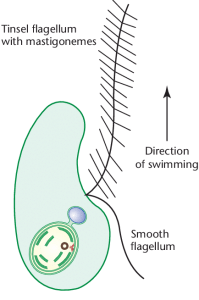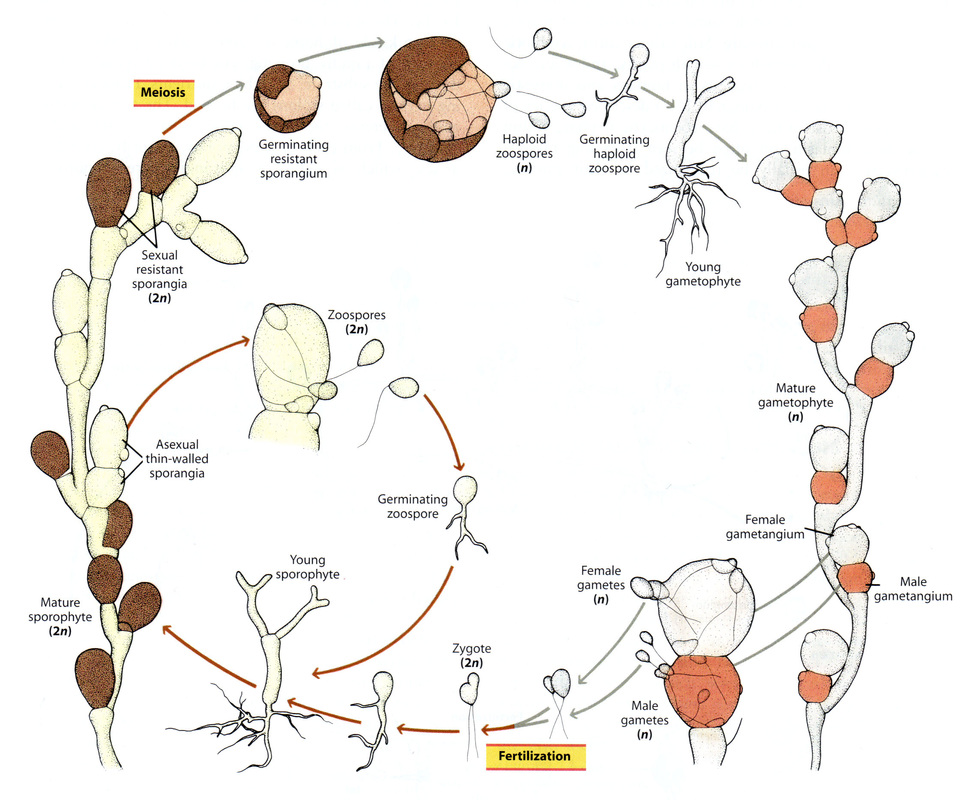Subkingdom: Mycota
Division: Eumycota
Sub-division: Mastigomycotina
- G.C. Ainsworth’s system of classification includes Mastigomycotina which is a subdivision under Eumycota.
- It is known to be the first subdivision under eumycota.
- It is a motile fungus.
- These consist of large heterogenous fungi
- 75000 species have been reported under this category.
- These are majorly known by the presence of motile flagellated spores called zoospores (spores which show motility). This feature is unique to this subdivision known as zoosporic fungi.
TYPES OF ZOOSPORES
There are 3 types of zoospores.

- Single Anterior flagellum- Tinsel type
- Single Posterior flagellum – Whiplash type
- Biflagellated zoospore (Reniform or kidney-shaped) – Anterior Tinsel type and posterior whiplash-type
General Characteristics
- They have aseptate and coenocytic mycelium
- The septae formation may take place in old hyphae during the reproductive stage.
- The cell wall is made up of chitin and cellulose
- The protoplast is vacuolated and has numerous nuclei
- The protoplasm have oil droplets that act as food reserves
- The reproduction may be vegetative, sexual, and asexual.
- They may be saprophytic, parasitic
Distribution
- These are found in a variety of habitats such as Aquatic habitat, freshwater or marine, and soil
- The aquation fungi are known as water molds.
- They live either saprophyte on plant/animal debris or parasite on algae, fungi, and plants
- A few species live on the damp soil and these survive as saprophytes and may be responsible for few diseases like root rot
- A few are responsible for destructive diseases in plants/crops.
Classification
These are further subdivided into 4 classes based on the type of flagellum, the position of the flagellum, and the number of flagellum attached.
- Chytridiomycets- Single Posterior flagellum – Whiplash type, aquatic, parasitic or saprophytic in nature
- Hypochytridiomycetes- Single Anterior flagellum- Tinsel type, aquatic or terrestrial, parasitic in nature
- Oomycetes- Biflagellated zoospore- Anterior Tinsel type and posterior whiplash-type, freshwater or marine water, saprophytic or parasitic in nature
- Plasmodiophoromycetes– Biflagellated zoospore- Anterior Tinsel type and posterior whiplash-type, aquatic or marine, parasitic in nature
Reproduction
The reproduction may be vegetative, asexual or sexual.
Vegetative
- Fragmentation- The vegetative mycelium or hyphae break into several fragments that have the capability to grow into new mycelium under favorable conditions.
- Clamadospores- Hyphal tips are mostly swollen and they get separated by a septum and then germinate to form mycelium.
Asexual Reproduction
- Through Zoospores- ie. the difference is by type of flagellum, the position of the flagellum, and a number of flagellum attached. uniflagellate posterior type or uniflagellate tinsel type or biflagellated.
Sexual Reproduction
- Gametic Copulation or Planogametic copulation involves the fusion of two naked gametes
- Gametangium Copulation– The conjugation between the gametangia that leads to protoplasm fusion and ultimately nucleus forming spores.
- Gametangial contact– The conjugation tube is formed between the gametangia and the transfer of nucleus tales place leading to meiosis and formation of spores that form new hyphae.
Lifecycle
CHYTRIDOMYCETES
PLASMODYOPHOROMYCETES
Economic Importance
- Chytrids cause wart disease of potato, wart diseases in roots of crucifers, crown wart of alfalfa, a brown spot of maize,
- Oomycetes are responsible for late blight of potato, downy mildew, damping-off, fruit rot(Pythium species), footrot (Pythium species), white rust (Albugo),
- Few have been reported as biocontrol agents.
- Hypochytrids form an important group in marine or freshwater biodiversity.
References
https://link.springer.com/chapter/10.1007/978-94-011-1496-7_3
http://eagri.org/eagri50/PATH171/lec06.pdf
More Topics To Read


